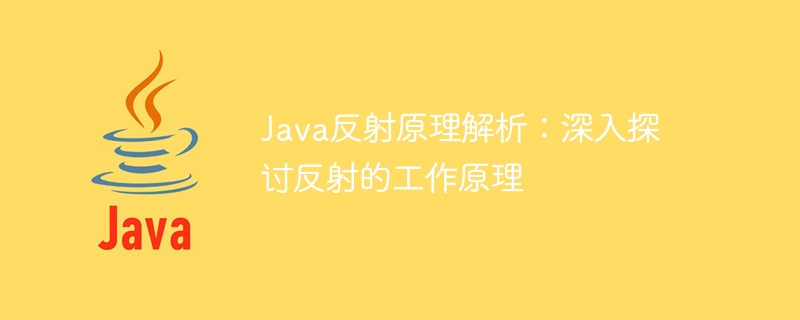

Java reflection principle analysis
Java is an object-oriented programming language, and reflection is one of the important features of the Java language. Through reflection, we can dynamically analyze and operate the classes, objects, interfaces, etc. of Java programs. It provides programmers with a mechanism to obtain various information of a class at runtime, such as methods, fields, constructors, etc., as well as dynamically call class methods, instantiated objects, etc.
In this article, we will delve into how Java reflection works and provide some specific code examples to help readers better understand the practical application of reflection.
1. The basic concept of reflection
In Java, each class has a corresponding Class object, which contains all the information of the class. Through the Class object, we can obtain the constructor, methods, fields and other information of the class, and can operate through this information. This ability to dynamically obtain and operate classes is the core of Java's reflection mechanism.
Suppose we have a class named "Person". Through the reflection mechanism, we can obtain the Class object of this class at runtime, and further obtain the constructor, methods and other information of the class, and perform Instantiation, calling methods and other operations. Below we use a specific example to demonstrate the basic use of reflection.
public class Person {
private String name;
private int age;
public Person(String name, int age) {
this.name = name;
this.age = age;
}
public void sayHello() {
System.out.println("Hello, my name is " + name + ", and I am " + age + " years old.");
}
}import java.lang.reflect.Constructor;
import java.lang.reflect.Method;
public class ReflectionDemo {
public static void main(String[] args) throws Exception {
// 获取Class对象
Class<Person> personClass = Person.class;
// 获取构造函数
Constructor<Person> constructor = personClass.getConstructor(String.class, int.class);
// 实例化对象
Person person = constructor.newInstance("Tom", 25);
// 获取方法
Method method = personClass.getMethod("sayHello");
// 调用方法
method.invoke(person);
}
}In the above example, we first obtain the Class object of the class through "Person.class", then obtain the constructor and sayHello method, and call these methods through the reflection mechanism. This is the basic use of Java reflection.
2. The working principle of reflection
After understanding the basic concept of reflection, let us discuss the working principle of reflection in depth. In fact, Java's reflection mechanism is mainly implemented through two important classes, namely the Class class and related classes under the java.lang.reflect package.
In addition, for each class, the JVM will automatically create a corresponding Class object when loading the class, and during the entire program running, the Class object corresponding to each class will only have one. Therefore, the Class object of the class can be obtained through "class name.class", "object.getClass()" or "Class.forName()".
Through these classes, programmers can dynamically obtain various information of the class at runtime and perform corresponding operations. Among them, the Constructor class is used to describe the constructor of the class, the Method class is used to describe the method of the class, and the Field class is used to describe the fields of the class.
Through the above explanation, we already have a certain understanding of how reflection works. Next, we will also explain the practical application of reflection in detail through specific code examples.
3. Practical Application of Reflection
The reflection mechanism is widely used in Java. It provides programmers with a flexible way to analyze and operate various information of classes at runtime. Below, we will use some common examples to illustrate the application of reflection in actual development.
Through the above examples, we can see the wide application of reflection mechanism in actual development. It provides programmers with a flexible way to analyze and manipulate various information of classes at runtime, as well as implement some common functions.
4. Summary
Through this article’s analysis of the principle of Java reflection, we have a certain understanding of the basic concepts, working principles and practical applications of reflection. Through specific code examples, we demonstrate the basic use of reflection, and explain in detail the working principle and practical application scenarios of reflection.
In general, the reflection mechanism provides Java programs with the ability to dynamically analyze and operate classes. It provides programmers with a flexible way to obtain and operate classes at runtime. various information, and implement some common functions. Therefore, for Java programmers, an in-depth understanding and proficiency in the reflection mechanism will help improve their programming skills and ability to solve practical problems.
The above is the detailed content of A deep dive into how Java reflection works. For more information, please follow other related articles on the PHP Chinese website!




